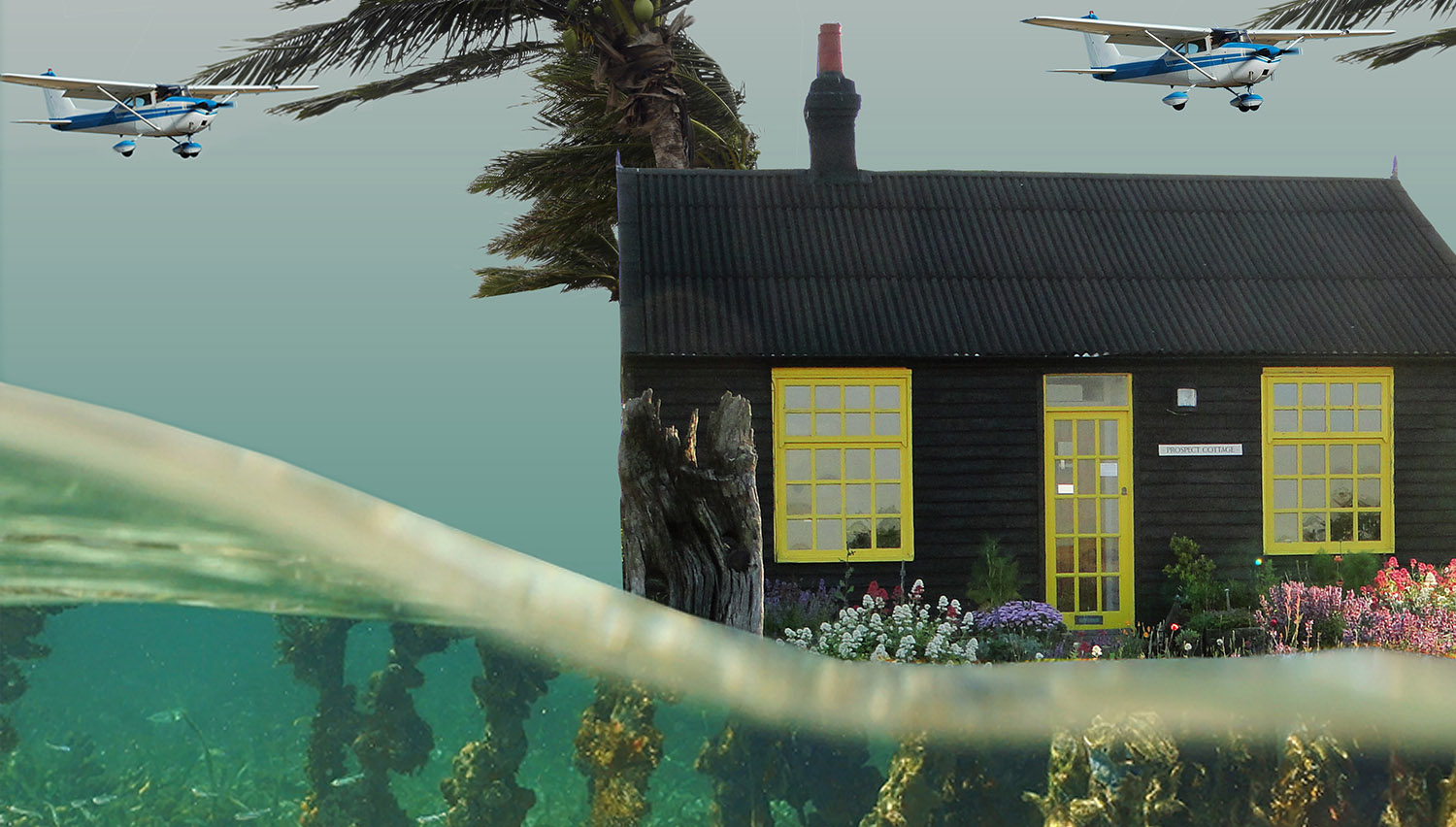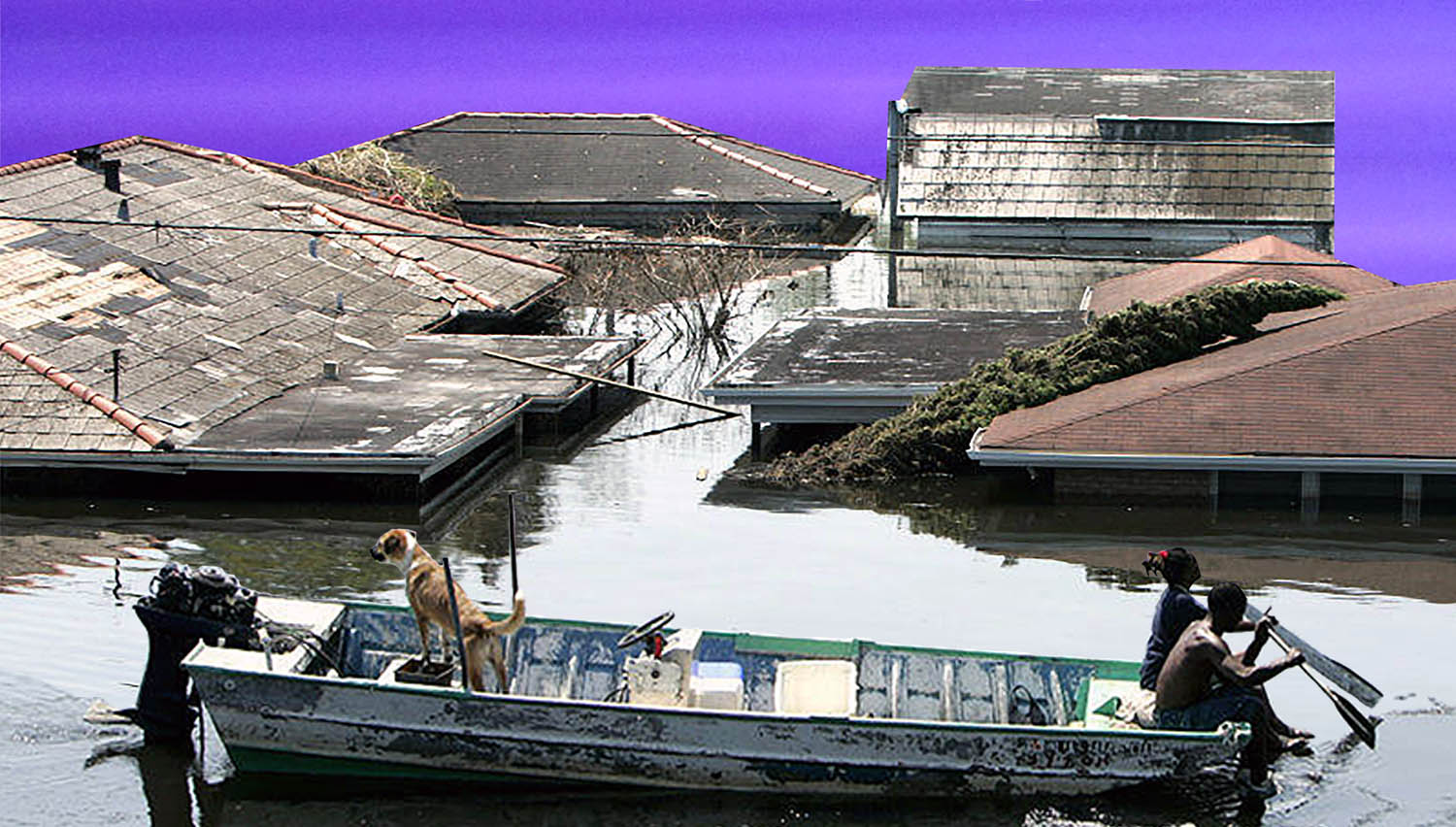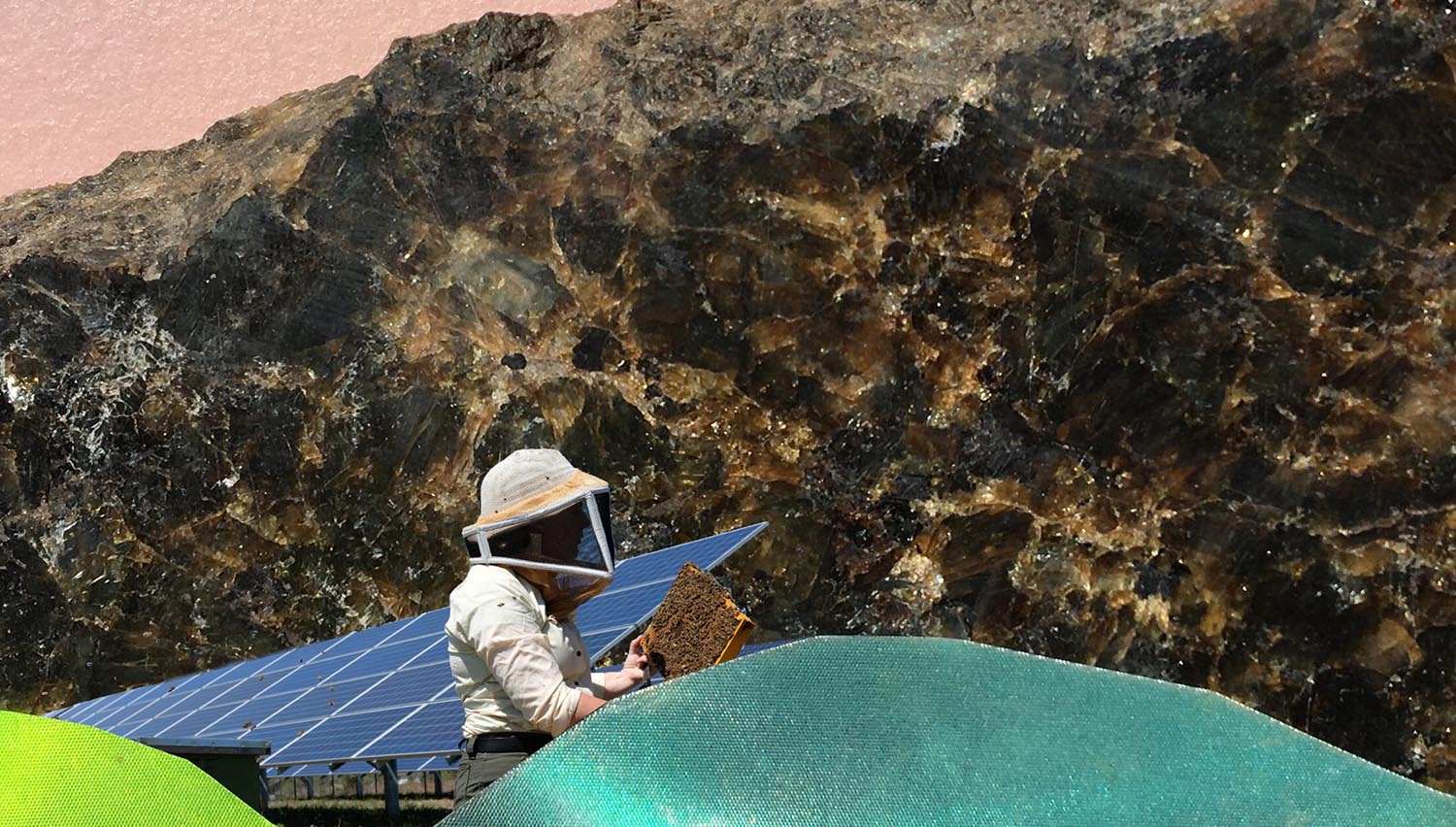Climate change is here. In the midst of the storm, an opportunity arises to break with capitalism and its vicious inequality. Let’s seize it while we can. The alternatives are unthinkable.
“What is this feeling that crops up during so many disasters?” asks Rebecca Solnit in her 2009 book A Paradise Built in Hell. Examining human responses to earthquakes, fires, explosions, terrorist attacks, and hurricanes over the last century, Solnit asserts that the commonplace idea that disasters reveal the worst in human nature is misguided. Instead, she shows how we can see in many such events “an emotion graver than happiness but deeply positive,” a purposeful hope that galvanizes what she calls “disaster communities.” When the prevailing social order temporarily fails, a host of “extraordinary communities,” constituted through collectivity and mutual aid, spring up in response. (Solnit’s examples include Hurricane Katrina, 9/11, and the Mexico City earthquake of 1985.) For fleeting moments, we forget social differences and help each other. Alas, when the disaster has passed, these communities subside. In the terms of A Paradise, the “great contemporary task” we face is the prevention of that subsidence, “the recovery of this closeness and purpose without crisis or pressure.” Given the calamity of our warming planet, this task becomes ever more urgent. How do we dismantle the social orders that make disasters so disastrous, while at the same time making ordinary the extraordinary human behavior they elicit?
Solnit’s argument rings true even if one is less optimistic than she about the inherent value of community. In the hells of the present, we find the tools we need to build other worlds, as well as tantalizing glimpses of something often thought impossible. This is not cause for celebration, nor even optimism. But it is cause for hope.
For this hope to be realized, however, we must go beyond Solnit’s empirical focus on what happens in response to specific disaster-events and grasp the character of the capitalist disaster. This is not simply a series of punctuated dates and place names—Katrina and Harvey and Irma, 1755 and 1906 and 1985—but an ongoing condition. For many, the ordinary is a disaster. Any coherent response to such continuous disaster will likewise have to be widespread and durable in order to succeed. Building paradise in hell is not enough: we must work against hell and go beyond it. More than disaster communities, we need disaster communism.
Assuredly, in calling for disaster communism, we are not suggesting that the occurrence of more and more frequent eco-social nightmares will somehow inevitably produce ever riper conditions for communism. We cannot adopt the perverse fatalism of “the worse, the better,” nor wait for some final hurricane to blow away the old order. Rather, we are noting that even the largest-scale and most terrifying of these extraordinary disasters can interrupt the ordinary disaster that is, most of the time, too large to fully comprehend. These are moments of interruption that, while horrific for human life, might also spell disaster for capitalism.
Disaster communism is not divorced from existing struggles. Rather, it emphasizes the revolutionary process of developing our collective capacity to endure and flourish: a movement within, against, and beyond this ongoing capitalist disaster. How can the numerous projects creating mini-paradises in hell cohere into something more than ephemeral communities? “Disaster communism” adds a clarifying epithet to the already long-ongoing political project that pits itself against the state and capital and overflows their bounds. It orients the movement of a collective power that, while rendered palpable during extraordinary disasters, was there all along, especially in places and among groups who have been experiencing the situation of ordinary disaster for hundreds of years. Climate change throws the skills central to those struggles into stark relief.
Disaster Capitalism, Capital as Disaster
The geographer Neil Smith convincingly argued that there’s no such thing as a natural disaster. Naming disasters “natural” occludes the fact that they are just as much the product of political and social divisions as they are of climatic or geological forces. If an earthquake destroys the poorly constructed and badly maintained low-income housing in a town but leaves the well-built homes of the rich standing, blaming nature merely lets states, developers, and slumlords (not to mention the capitalist economy that produces such inequality in the first place) off the hook. Disasters are always co-productions in which natural forces such as plate tectonics and weather systems work together with social, political, and economic forces.
The way in which extraordinary disasters play out, then, cannot be separated from the ordinary disaster conditions in which they occur. It was the category 4 Hurricane Maria that devastated the US colony of Puerto Rico, leaving residents without fresh water: a disastrous event. But to abandon the narrative here obscures the fact that, prior to the hurricane, “99.5 percent of Puerto Rico’s population was served by community water systems in violation of the Safe Drinking Water Act,” while “69.4 percent of people on the island were served by water sources that violated SDWA’s health standards,” according to a Natural Resources Defense Council report. Nor should such devastating events eclipse slower-moving disasters such as that of Flint, Michigan, where decades of neglect and industrial pollution of the surrounding Flint River and Great Lakes have similarly left working class, majority Black and Latinx communities without clean water. Easily overlooked because they lack the spectacular power of a hurricane or earthquake, such drawn-out disasters blur the boundary betweendisaster-as-event and disaster-as-condition. What comes as a sudden and unexpected jolt for many is for others a matter of everyday reality intensified.
“Building paradise in hell is not enough: we must work against hell and go beyond it. More than disaster communities, we need disaster communism.”
Climate change significantly increases the frequency and severity of both slow- and fast-moving disaster. Global warming means an increased amount of energy circulating in the atmosphere and ocean surfaces. For example, when warm oceans create low-pressure cells, thermal energy, under the influence of the Earth’s rotation, is converted into the kinetic energy characteristic of swirling hurricanes and tropical storms. Warmer temperatures give rise to more energy, which has to be expressed somehow. (Energy cannot be destroyed: it can only change form.) The physics of this process are fiendishly complex and difficult to model, yet it is possible to make forecasts. The latest report from the UN’s Intergovernmental Panel on Climate Change suggests climate change will disrupt food and water supplies, damage homes and infrastructure, and bring droughts and floods, heat waves and hurricanes, storm surges and wildfires. Advances in attribution science and knowledge gleaned from the single degree Celsius of global warming already in effect have made it possible to quantify the contribution of climate change to individual extreme weather events. We can now link global warming to calamities such as the European heat wave of 2003 and the Russian heat wave of 2010, which each killed tens of thousands of people, not to mention countless storms, floods, and other weather events.
That climate change is itself human-made (or rather, capitalism-made) further underscores the impossibility of separating disastrous events from disastrous conditions. The relationship between the two runs both ways: conditions give rise to events which, in turn, further entrench conditions. The goal of the nation-state during and in the immediate aftermath of extraordinary disasters is usually to impose order rather than to assist survivors, and for this reason disaster events generally exacerbate the underlying disaster of capitalism. In the 1906 San Francisco earthquake, the army was sent in. Between 50 and 500 survivors were killed, and self-organized search, rescue, and firefighting efforts were disrupted. The state’s attempts to manage disaster showed themselves to be a disordering force, destroying bottom-up forms of self-organization. A similar repressive focus on “looters” (i.e. survivors) marked the US state’s response to Hurricane Katrina in New Orleans. On September 4, 2005, on Danziger Bridge, seven police officers opened fire on a group of Black people attempting to flee the flooded city, killing two and seriously injuring four more. The murder of Black survivors seeking safety illustrates the means by which the state seeks to foreclose the emancipatory possibilities that might appear during such disasters. In such situations, the state seeks nothing more than a return to disastrous normality for poor, migrant, and Black people. Such actions are contrary to the recommendations of even mainstream sociologists of disaster. In the 1960s, for example, the military strategist-turned-sociologist Charles Fritz argued trenchantly that the stereotype of widespread antisocial individualism and aggression flourishing during disasters was not grounded in reality. He also astutely noted that the distinction between disasters and normality can “conveniently overlook the many sources of stress, strain, conflict, and dissatisfaction that are imbedded [sic] in the nature of everyday life.”

The disastrous machinations of state and capital do not stop at localized and punctual events, however, but scale from the neighborhood to the planet. As writers such as Naomi Klein and Todd Miller have demonstrated, extraordinary disasters are used to prolong, renew, and extend the ordinary disasters of austerity, privatization, militarization, policing, and borders. This is disaster capitalism: a vicious cycle in which ordinary disaster conditions exacerbate extraordinary disaster events, in turn intensifying the original conditions. Disastrous events allow the state to implement what Klein calls the “shock doctrine.” This process involves redeveloping destroyed housing, energy, and distribution infrastructures to neoliberal standards; pricing the poor out of electricity or clean water; forcing them to relocate to locations even more vulnerable to climate change; and incarcerating them when they resist or try to cross borders to escape this untenable situation. In the months following Hurricane Maria, Puerto Rico has experienced further privatization, worsening labor conditions, and the arrival of green colonialists: supposed do-gooders like Elon Musk hiding their latest hyper-capitalist ventures behind the thinnest veneer of environmental recovery. The story in Flint is similar, right down to Musk’s offers to solve its infrastructural issues.
Forces acting in the interests of state and capital come in a number of shapes, of course. Activists from the Common Ground Collective providing emergency relief in the aftermath of Hurricane Katrina were intensively harassed not only by racist cops but also by armed white locals who seized the opportunity to roleplay a postapocalyptic end-times scenario, with the tacit approval, and sometimes active facilitation, of the police.
Survival Pending Revolution
What the study of disastrous events and disastrous conditions teaches us is that climate change is not simply an unintended consequence of capitalist production but a crisis of social reproduction (a term referring to the self-perpetuating social structures that enable daily and generational survival while at the same time maintaining inequality). Acknowledging this does not just give us a new angle on the problem, but also points to a source of hope. It is important to remember that the lives of the poor, the dispossessed, and the colonized are not shaped by disaster alone. They involve, at every turn, forms of survival and persistence, often in the form of knowledges and skills passed from generation to generation. As the Potawatomi philosopher Kyle Powys Whyte insists, while indigenous peoples are quite familiar with disaster in the form of hundreds of years of attempted colonial domination, over those hundreds of years they have developed the skills to resist and survive ordinary and extraordinary disasters. The Marxist-feminist scholar Silvia Federici, meanwhile, has shown how capitalism has long endeavored, unsuccessfully, to violently eradicate all forms of non-capitalist survival. In her 2001 essay “Women, Globalization, and the International Women’s Movement,” she argues that “if the destruction of our means of subsistence is indispensable for the survival of capitalist relations, this must be our terrain of struggle.”
Such struggle occurred in the aftermath of the 1985 Mexico City earthquake, when landowners and real estate speculators saw an opportunity to finally evict people they’d been wanting to get rid of for a long time. Their attempts to tear down housing that was providing low rental returns and replace it with expensive high-rise condos is a clear example of disaster capitalism at work. Yet working class residents fought back with great success. Thousands of tenants marched on the National Palace, demanding the government take possession of damaged homes from their propertied landlords for eventual sale back to their tenants. In response, some 7,000 properties were seized. Here, then, we see that extraordinary disasters don’t simply create space for the state and capital to entrench their power, but for resistance to these very forms: a “shock doctrine of the left,” to adopt Graham Jones’ phrase. The ordinary disaster that is capitalism can in fact be interrupted by these incidents that, while horrific for human life, also spell momentary ruin forcapitalism. In a 1988 essay titled “The Uses of an Earthquake,” Harry Cleaver suggests this is particularly likely in the breakdown of administrative capacity and government authority following extraordinary disasters. This breakdown is perhaps even more likely in places where governance is reliant on surveillance, smart data, and information technologies.
“What comes as a sudden and unexpected jolt for many is for others a matter of everyday reality intensified.”
Cleaver also notes the importance of histories of collective organizing in neighborhoods affected by the earthquake. Survivors had organizational links, a culture of mutual aid, and expectations of solidarity. Tenants knew that they had each other’s backs because of their past relationships with one another. This point is crucial, for it allows us to understand disaster community, not simply as a spontaneous response to extraordinary disasters, but rather as the coming to the fore of everyday struggles for survival and subterranean practices of mutual aid. Their experience of organizing against the ordinary disasters of capitalism left residents well equipped to deal with an extraordinary disaster.
Indeed, preexisting relations of support have been most effective in sustaining communities in the wake of Hurricane Maria. Centros de Apoyo Mutuo is a decentralized mutual aid network drawing on established groups, centers, and practices, which has distributed food, cleaned up debris, and rebuilt the island’s infrastructure. It has done so faster, and with greater attention to residents’ needs, than networks of international aid and logistics. Through a kind of bricolage or “art of making do with what is at hand,” mutual aid centers demonstrate that nonspecialists can quickly pick up and share tools and skills for survival. In doing so, they also create new forms of solidarity and collective life that go beyond survival.
“Those storms have swept by, and they’ve destroyed many things,” says Ricchi, a member of the US-based network Mutual Aid Disaster Relief. “By knocking out the energy grid, and cutting access to food and water, they left the island of Borikén [the Indigenous Taíno name for Puerto Rico] dark. But in that darkness countless Boricuas have awoke, and they stay awake late and get up early again, doing the work of reproducing life.”
That life isn’t just mundane: groups organize parties, dancing lessons, and collective cooking sessions, so that communal horizons might open beyond despair.
In a conventional and narrowly economic sense there is scarcity in these situations, albeit scarcity challenged by an abundance of social links. Yet extraordinary disasters can also push us to recognize that scarcity is a social relation rather than a simple fact of number: the way goods and resources are distributed determines who can use them. In the aftermath of Hurricane Sandy, a “scarcity” of tools was overcome, not through the production or acquisition of more, but through new organization. Tool libraries were set up as alternatives to the individualized, commodified social relations that dominate capitalist society. They show us that we should not be too hasty to associate climate change with increased scarcity.
Disaster Migration
Communities are often defined by their containment within a specific geographic place, and those we have cited above certainly fit this bill: they respond to extraordinary disasters at the sites of those disasters. Yet climate change, of course, forces people from place to place, so that organizing against its disastrous effects also requires broader communities of solidarity. The number of people currently classed as “forced displaced” currently stands, by UN figures, at 68.5 million. The quickening of this wave of displacement is impossible to ignore. By 2050 there are forecast to be 200 million people who will be “environmentally displaced”: forced to move because of the disasters, both ordinary and extraordinary, that a warming world brings. This, to hammer home the point, is 1 out of 50 people in the world.
Currently, many people are displaced internally, with only a small fraction traveling to Europe, North America, or Australia. However, as the climate destabilizes and conditions worsen, many of the places currently serving as refuges will become uninhabitable. Traveling to higher latitude zones and crossing the borders of the richer nations which occupy them will thus become ever more essential to people. Living there makes one less vulnerable to disastrous events, not least because rich nation-states remain better equipped—at least financially—to mitigate them. The trend towards global movement north will likely intensify efforts to defend these zones: the astonishingly self-described “military-environmental-industrial complex” is already plotting new forms of violence to defend borders. Communal efforts to combat such violence will form some of the most important struggles against climate disaster.
As we write, several Immigration and Customs Enforcement facilities across the US are under blockade, as part of a nationwide attempt to disrupt their roundup and deportation operations. In the UK, campaigners have successfully pushed back the government’s attempts to extend immigration enforcement into schools as part of its “hostile environment” policy. In Glasgow in the 1990s, a buddy scheme pairing recent migrants with locals was so successful that working class communities turned out to obstruct dawn raids aiming to deport their new friends and neighbors. To our mind, these, too, are disaster communities, and they are no less important than those in post-’85 Mexico City and post-Katrina New Orleans.

These disaster communities, then, are glimpses of hope: microcosms of a world formed otherwise. Social reproduction orchestrated not through waged labor, commodities, private property, and all their associated violence, but through care, solidarity, and the passion for freedom. The ordinary, they insist, is not a given.
Paradise Against Hell
This hope is vital, yet all too often hope kills us. We need more than microcosms, not least because such experiments can be valuable for capital too. Here it’s important to note that capital is not homogenous: what is good for some capitalists is bad for others, and what is bad for individual capitalists over a short period of time may be good for capital in the long run. Thus, while disaster communities might spell bad news for some capitalists and state actors, others will look to mine them for value. As Ashley Dawson reminds us, the US Department of Homeland Security praised the anarchist-influenced relief efforts of Occupy Sandy after the 2012 hurricane swept through New York. In doing so well what state and market forces could not do, Occupy’s projects kept social life going, giving these forces something to recapture once the status quo ante was restored. And they did so at no direct cost to the state.
Such an account is partial, of course, and misses the pedagogic value of disaster communities. At its most powerful, this value is simultaneously negative and positive: the resounding “yes” to those other ways of living screams “no” to the ordinary disaster of capital. The social reproduction fostered is a change of direction: an attempt to reproduce ourselves otherwise, and to resist a return to business as usual that would leave our bodies and our ecosystem exhausted.
We see this clearly in many of the disaster communities that spring up in response to borders. As Harsha Walia so brilliantly demonstrates in Undoing Border Imperialism, these do not simply help people mitigate the violence of the border, but resist the very concept of the border itself, as succinctly put in the widely heard demand for No Borders. Indeed, this very phrase conjures up the simultaneous affirmation and negation we insist upon: opposing a facet of this world while describing features of the next. This is an operation against, as well as in, hell.
Such negation will undoubtedly need to go beyond the coziness associated with dominant notions of community. When faced with those racist cops and vigilantes in the aftermath of Hurricane Katrina, the Common Ground Collective engaged in armed self-defense inspired by the Black Panthers and other radical groups. Nor will the conflicts only exist externally: the CGC also had to deal with supporters who seemed more interested in catastrophe tourism than their relief efforts. Disaster communities will not be free from the welter of violence that constitutes everyday disaster: misogyny, white supremacy, classism, ableism, racism, and numerous intersecting forms of oppression will, sadly, leak into their organizing. Disaster communities will have to learn how to resolve things otherwise, mobilizing social tools and accountability processes many activists are already developing today.
Paradise Beyond Hell
Capitalism is comfortable with community. All too often, the term is used to label the resilience capitalism itself needs to survive ordinary and extraordinary disaster. Community names collectivity stripped of all transformative power.
We cannot abandon the concept of community altogether: such a proposal would be unhelpfully idealistic, given the term’s widespread use. But to refer to disaster communities such as those discussed above merely as “communities” is to deny their potential, binding them to a present in which they are forever admirable, but never transformative.
And so we insist on communism.

Where communism is frequently premised on the material abundance created by capitalist production, disaster communism is grounded in the collective abundance of disaster communities. It is a seizing of the means of social reproduction. We cannot expect, of course, that each and every outcome will be immediately communist (private property was not abolished in those communities in Mexico City in 1985, for example). Our use of the term signals the extensive ambition and operation of a movement beyond specific manifestations and outcomes, its spread across space, and its continued existence beyond extraordinary disasters. It names the ambition to ground nothing less than the whole world in the abundance found in the social reproduction of the disaster community. As such, it fulfills the definition of communism that Marx gives us: “the real movement which abolishes the present state of things.”
The communism of disaster communism, then, is a transgressive and transformative mobilization without which the unfolding catastrophe of global warming cannot and will not be stopped. It is simultaneously an undoing of the manifold structural injustices which perpetuate and draw strength from disaster, and an enactment of the widespread collective capacity to endure and flourish on a rapidly changing planet. It is hugely ambitious, requiring redistribution of resources at several scales; reparations for colonialism and slavery; expropriation of private property for Indigenous peoples; and the abolition of fossil fuels, among other monumental projects. We are, clearly, not there yet. But as Ernst Bloch noted, that “not-yet” is also in our present. In the collective responses to disaster, we find that many of the tools for constructing that new world already exist. When Solnit talks of that emotion “graver than happiness” which animates people in the wake of disaster, she catches “a glimpse of who else we ourselves may be and what else our society could become.” Amidst the ruins, within the terrible opening of the interruption, pitched against the conditions that produce and seek to capitalize upon that interruption, we are close to complete change, to the generalization of the knowledge that everything—and everyone—might yet be transformed. In other words, in the collective response to disaster, we glimpse a real movement which could yet abolish the present state of things.






